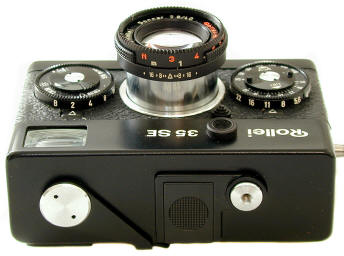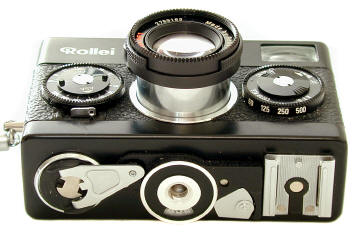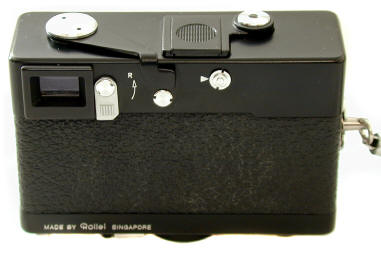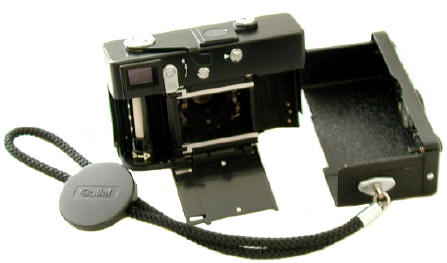
Home
Camera
Articles FOR SALE
Orders
I Buy / Wants Repairs
Books Adapters
Rollei 35 SE
Rollei started the compact 35 race in 1966 with its best selling Rollei 35. Though not too earth shattering by today's standards, the Rollei 35 was truly revolutionary for its time when it was the smallest full frame 35 in the world. Never before had such quality construction with a sharp lens been combined in such a small package. The Rollei 35 family turned out to be fabulously successful, with over two million sold in its various guises.
Each Rollei 35 was thankfully labeled on the top plate, making identification today very easy. All shared the same high quality, strange quirky camera design. Variations existed mostly in terms of lenses, metering systems, and special commemorative finishes. Lens choices were non-interchangeable: the superb 40/2.8 Zeiss Sonnar, the excellent 40//3.5 Zeiss Tessar, and the passable low cost 40/3.5 Zeiss Triotar. Most Rollei 35's were chrome finish, though black was an option with most models. Special collector's models were available in gold or silver, and even platinum. Initially production was in Germany, with Zeiss lenses. After several years, production was switched to Singapore with lenses made by Rollei under license from Zeiss. Collectors place a premium on the German made cameras, though the later Sonnar cameras are certainly better shooters.


The diminutive 35 SE weighs 12 oz with battery, without film. It measures 3 13/16" long, 2 5/8th high, with a body depth of 1 1/4" which increases to 1 11/16th including the recessed lens. Filter size is 30.5 mm.
All Rollei 35 models share the same basic body with the same quirky features:


The 35SE featured an easy to take out PX27 5.6 Volt battery. Just move the button on the back of the top plate, and the battery pops up. Early Roller 35's had the battery hidden inside the body cavity. You had to unscrew the unmarked cover, which made it a good place to forget about them, and for the batteries to eventually leak. The PX27, in its present form a 6v battery, is MUCH easier to find today than the old mercury 625 for most of the other Rollei 35's. Of course, the battery compartment is kind of ugly on top of the camera. I wonder if it's true, that you can't have everything?
The Rollei 35SE was the highpoint of Rollei 35 design, with the best Sonnar lens, and the best LED metering system. Produced for only two years, the 35SE is hard to find today. The SE, like the 35S, has a multicoated HFT lens focusing down to 3 feet. Unlike the Tessar or Triotar, the Sonnar is a unit focusing lens rather than a front element focusing lens. Modern Photography said that the Sonnar was noticeably better than the Tessar, especially at wider apertures and at closer distances. It's also worth mentioning that the 35 SE had the best lens test results of any compact full frame 35 tested by Modern. So far as I know, the Tessar and Triotar were never multi-coated. The CDS cell is mounted on the front of the camera in the top plate, for a non TTL meter reading. Unfortunately it will not automatically compensate if you use filters. To take a meter reading, press the shutter release slightly to activate metering system, and then adjust the f/stops and shutter speeds to get a green LED. Over or under exposure was indicated by Red LEDs. The ASA range of 25 to 1600 is set on the center of the front f/stop dial.
Though I can live with the Rollei 35 unusual design, I really wish Rollei had chosen a 35mm lens rather than the 40mm. The Rollei 35's great popularity practically reinvented the 40mm focal length. Unfortunately many other manufacturers followed Roller's lens choice on their own compact 35's of the late 60's and 70's. 40mm is a kind of in-between focal length, too long to be a wide angle, and too short to be a useful normal. I feel a 35mm lens would have resulted in a far more useful camera. Offering models with 28mm or wider lenses would have been nice too. To date, Rollei 35 owners have had the choice of any focal length lens they want, so long as it's 40mm.

Rollei 35's (Sonnar and Tessar lensed models) amount to the Volkswagens of the camera world. People loved their construction quality and lens performance so much, they overlooked a very strange and often inconvenient camera design. If you want a fast operating compact 35, none of the Rollei 35 models qualify. On the other hand, if you want a superbly made metal compact camera with a great lens, this just might be your cup of tea.
To the Rollei 35's credit, I doubt there is a better built full frame 35 camera as small. Nonetheless, compared to the little appreciated and certainly not so well made Petri 35, the Rollei 35's are rather badly designed. See Rollei 35 vs. Petri 35 comparison chart
As strange as they are, the various Rollei 35's have a feeling of workmanship and craftsmanship that many photogs fall in love with. Rollei 35's have kind of a semi-cult following, sometimes bordering on insanity. I frankly don't share the enthusiasm, finding all Rollei 35's models rather awkward little cameras to shoot. Nevertheless, their incredible sales success and popularity clearly show an enthusiastic and dedicated following.
Quick List of Rollei 35's per Arthur Evans' excellent "Collector's Guide to Rollei Cameras"
Rollei 35 SE 40/2.8 Sonnar 1980-82 Rollei 35S Silver 40/2.8 Sonnar 1979 Rollei 35 S Gold 40/2.8 Sonnar 1974-6 Rollei 35 S Royal Urushi 40/2.8 Sonnar ? Rollei 35 S 40/2.8 Sonnar Rollei 35 TE 40/3.5 Tessar 1980-82 Rollei 35 T 40/3.5 Tessar 1976-80 Rollei 35 Gold 40/3.5 Tessar 1971-2 Rollei 35 40/3.5 Tessar 1967-75 Rollei 35 LED 40/3.5 Triotar 1978-80 Rollei C 35 40/3.5 Triotar 1969-71 Rollei B 35 40/3.5 Triotar 1969-71
Yes, various commemoratives followed trying to cash in on Rollei 35 popularity. The Sonnar lenses are better than the Tessar, which are better than the Triotar.
Revised: November 26, 2003 . Copyright � 1998-2002 Stephen Gandy. All rights reserved. This means you may NOT copy and re-use the text or the pictures in ANY other internet or printed publication of ANY kind. Information in this document is subject to change without notice. Other products and companies referred to herein are trademarks or registered trademarks of their respective companies or mark holders.